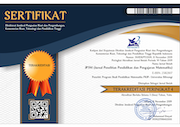Penggunaan model pembelajaran creative problem solving untuk meningkatkan kemampuan berpikir kreatif dan motivasi belajar matematika siswa
Abstract
learning motivation is still low, so to overcome these problems required a learning model that is more focused on students to be more active in thinking on the ability to think creatively, one of which is assumed to improve the Creative Problem Solving learning model ( CPS). This study aims to determine the improvement of students ‘creative thinking skills using the Creative Problem Solving (CPS) learning model compared to students who use conventional learning models and want to know students’ learning motivation. The method used in this study is the explanatory sequential type design (mixed method).Theinstrumentusedinthestudents’creativethinkingskillsintheformof a description problem consisting of seven items in addition to that was also strengthened by questionnaire, interview and observation width to support the test results. The population in this study is the eighth grade students of Rajagaluh 3 Junior High School, while the samples taken randomly according to the class are selected in class VIII-E as the experimental class and class VIII-D as the control class. The experimental class was given learning using the Creative Problem Solving (CPS) learning model and the control class was given learning using conventional learningmodels. Data analysis techniques using two average difference test, correlation test. Based on the results of the analysis and results of data processing, it was concluded that theimprovementofstudents’creativethinkingabilitywasbetterinthecontrolclass using conventional learning models compared to the experimental class using Creative Problem Solving (CPS) learning models and better Student Motivation in the control class compared to experimentalclass.
Keywords: Creative Problem Solving(CPS), learning model, creative thinking skills and Learning Motivation
Full Text:
PDFReferences
Fajariah, N.I., et.al. (2012). Keefektifan Implementasi Model Pembelajaran Problem Posing dan Creative Problem Solving terhadap Kemampuan Pemecahan Masalah Siswa di SMP N 1 Tengaran. Unnes Journal of Mathematics Eduction. ISSN No2252-6927
Ilies, R., & Judge, T.A. (2002). Relationship of Personality to Performance Motivation: A Meta-Analytic Review. Journal of Applied Psychology, 87(4), 797–807.
Kang, S.L., et.al. (2003). A Development Of The Test For Mathematical Creative Problem Solving Ability. Journal of the Korea Society of Mathematical Education Series D: Research in Mathematical Education, 7(3).
Maharani, Waluya, dan Sugianto. (2015). Humanistic Mathematics Learning with Creative Problem Solving Assisted Interactive Compact Disk to Improve Creative Thinking Ability. International journal of Education and research, 3.
Purwati. (2015). Efektifitas Pendekatan Creative Problem Solving Terhadap Kemampuan Pemecahan Masalah Matematika Pada Siswa SMA. Jurnal Ilmiah Edukasi Matematika (JIEM), 1(1).
Supardi. Peran Berpikir Kreatif Dalam Proses Pembelajaran Matematika. Jurnal Formatif 2. Tersedia: journal.lppmunindra.ac.id.
Tiurliana & Isrok’atun. (2014). Enhancing Students’ Mathematical Creative Problem Solving Ability Through Situation-Based Learning. Mathematical Theory and Modeling, 4 (11). Tersedia: http://www.iiste.org/Journals/index.php/MTM.
Victor, R.V (2009). Creative Problem Solving: An Applied University Course. Pesquisa Operacional, 30(2). Tersedia: http://www.scielo.br/pdf/pope/v30n2/09.pdf
DOI: https://doi.org/10.37058/jp3m.v4i2.605
Refbacks
- There are currently no refbacks.
©2017 JP3M (Jurnal Penelitian Pendidikan dan Pengajaran Matematika)
Program Studi Pendidikan Matematika
Fakultas Keguruan dan Ilmu PendidikanÂ
Universitas Siliwangi
Jl. Siliwangi No. 24 Kota Tasikmalaya - 46115
email: jp3m@unsil.ac.id
e-ISSN: 2581-2807 ; p-ISSN: 2460-8599

This work is licensed under a Creative Commons Attribution-NonCommercial-ShareAlike 4.0 International License.
StatCounter:
Detail


